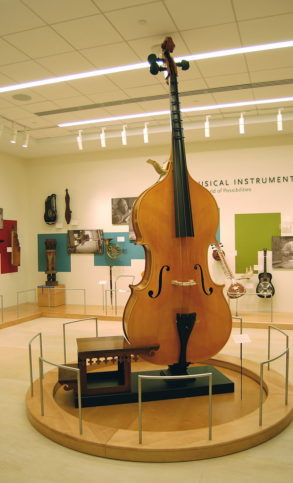
The double bass is also referred to as a contrabass, acoustic bass, and stand-up bass anyone using the term “bass violin” to identify it is in error.) **(The bass violin is not the same instrument as the double bass. No other instrument of the orchestra has this much variance among its ranks, both in terms of the design and the playing technique.)

*(If you look at the members of the double bass section of any orchestra, some of them will be playing four-string basses, some will have a “c extension” on the e string so it can go a few notes lower, while others will actually have five strings some will use a German bow that resembles a viola da gamba bow and is played underhand, while others use a French bow which resembles a large cello bow and is played overhand some of the basses will have sloped shoulders and a flat back like a viol while others will have round shoulders and a curved back like a violin some of the players will be standing up while others will be sitting on stools.

Since the design of the lowest member of the viol family was a constant work in progress throughout the 17th and 18th centuries (and even the modern double bass isn’t completely standardized*), the word violone was used as both as the name of a specific instrument - the contrabasso viola da gamba, with six strings and frets - and as a generic term referring to any bass bowed string instrument, including the now-defunct bass violin**, the true predecessor to the cello. But the nomenclature of string instruments became very messy by the late 17th century. It’s both more accurate and less confusing to consider the cello to be a large violin rather than a small bass, and it’s not a viol. You may think this is weird, and you would be right to think that. Through a similar linguistic process, the word violone, or “big viol,” denoting the predecessor to the modern double bass, acquired its own diminutive suffix to describe a smaller version, giving us the word violoncello or “small big viol.” (The final step toward the name most familiar to us happened when violoncello was frequently shortened to ‘cello and eventually lost the apostrophe.) Which brings us to how the cello got its name. The word for “small lemon” is limoncello, which is also the name of a liqueur made from small lemons (and would be a delightful thing to drink in the weather we’re currently having, but I digress.) Which means that the word for small lemon is literally “small big lime.”

The Italian word for the green citrus fruit we call a lime is spelled (but not pronounced) the same in Italian, which with its article is il lime (eel LEE-ma.) The Italian word for lemon is limone (pronounced lee-MO-nay) which literally means “large lime” (lime + the augmentative suffix -one). Things can get even more complicated when diminutive suffixes start interacting with augmentative suffixes.

And, to thicken the plot, sometimes these suffixes also create a word with a different (but related) meaning: mulino means mill, while mulinello means whirlpool. All well and good but, speaking of trees, ramo means branch while ramoscello means small branch, and orto means vegetable garden while orticello means small vegetable garden. So, for example, asino is donkey and asinello is little donkey, and albero means tree and alberello means small tree. Italian has several diminutive suffixes, and not only is there not a clear pattern as to how they’re used, but there are some variants of those suffixes that are unique to certain words, and those studying the language have no choice but to learn those words and their quirks. English is not the only language with some puzzling inconsistencies.


 0 kommentar(er)
0 kommentar(er)
